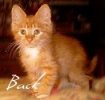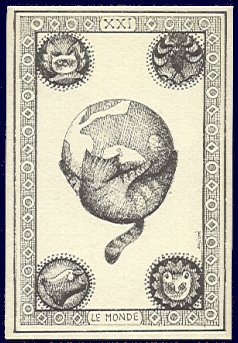 I Gatti Originali in 22 Arcani Maggiori by Evelyne
Nicod
I Gatti Originali in 22 Arcani Maggiori by Evelyne
NicodReview by Paula Gibby
 I Gatti Originali in 22 Arcani Maggiori by Evelyne
Nicod
I Gatti Originali in 22 Arcani Maggiori by Evelyne
Nicod
Review by Paula Gibby
I have been intermittently researching this deck for the past few years and, until just recently, it had always been rather a puzzle; a little puzzle that had scratched at my brain whenever I read another review or glimpsed the "I Gatti" title on the various deck inventories I review obsessively.
I think I would have solved the puzzle a lot more quickly if I had remembered a schoolteacher’s advice given to me quite a few years ago: "Sometimes, Paula, the most obvious answer is the correct one.". Of course, this is difficult advice to follow for someone who can sometimes excel in making almost anything difficult.
OK, here's the puzzle. Back when I first received my set of the Kaplan encyclopedias, my eyes were immediately drawn to a whimsical little set of majors called the "I Gatti Originali". They were attributed to the artistry of Evelyn Nicod (no "e" on the first name in the Kaplan volume) and published by Il Meneghello of Italy in 1985.
Cat admirer that I am, I immediately fell in love with them. I checked my U.S. Games catalog, which back then was one of my few sources for decks. Imagine my delight when I located the "I Gatti Originali" by Evelyn Nicod in the catalog.
But then, my brow furrowed in confusion. Although there were only a couple of images in the catalog, I could immediately tell that these were not the beloved images displayed in the Kaplan encyclopedia. How could this be explained? Both sources were from Kaplan, but these were definitely two different decks.
I immediately transported myself into endless cogitations. Perhaps the deck in Kaplan was a set of images especially prepared for the Encyclopedia (his volumes are full of "decks" like that) and the I Gatti in the catalog was the "official" printing. I really had no idea and there was no one to ask (I had not yet developed the wonderful network of tarot buddies that I have now). Not being someone who can just leave a puzzle alone, I called U.S. Games and was assured that the I Gatti deck in the catalog was indeed the work of Nicod. Hmmm.
To tell you the truth, I didn’t purchase the deck because I knew the images would just remind me of the disappointment I felt at not being able to have a copy of those delightful little creatures gazing wistfully at me from the pages of the encyclopedia. The images in the catalog – while very well done – seemed so staid in comparison.
I moved on to other tarot research projects, but always took the opportunity to review any possible leads to this mystery that came my way. As I continued to collect, I would hear other collectors discussing this very same puzzle. From people who owned the I Gatti distributed by U.S. Games, the question was always the same: Why was there no mention of Nicod on that deck? Why did the deck say the artist was Menegazzi (owner of the Il Meneghello publishing house)? The interesting thing about these discussions was that no one brought up the fact that the sets of images were completely different.
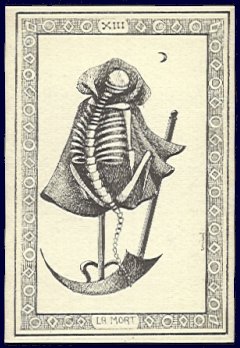 My interest perked up again after reading a review of the deck at
Wicce’s excellent site. Gina brought forward the same issue…the discrepancy in
artist. I became determined to get to the bottom of my four-year-old puzzle. I
purchased the I Gatti distributed by U.S. Games and also the I Gatti Buffi (a
charming deck published by the same house) and spent some time looking at them.
I’m no artist, but even I could tell that none of these images was the work of
the person who created the cards in the Kaplan encyclopedia. The I Gatti I held
in my hands could not possibly be an official edition of Nicod’s earlier work.
Besides, it clearly states that it was the work of Menegazzi (with no mention of
the word "originali" on the title card).
My interest perked up again after reading a review of the deck at
Wicce’s excellent site. Gina brought forward the same issue…the discrepancy in
artist. I became determined to get to the bottom of my four-year-old puzzle. I
purchased the I Gatti distributed by U.S. Games and also the I Gatti Buffi (a
charming deck published by the same house) and spent some time looking at them.
I’m no artist, but even I could tell that none of these images was the work of
the person who created the cards in the Kaplan encyclopedia. The I Gatti I held
in my hands could not possibly be an official edition of Nicod’s earlier work.
Besides, it clearly states that it was the work of Menegazzi (with no mention of
the word "originali" on the title card).
It was only then that I heeded the advice of my old teacher. There was no confusion here. I was making this much too difficult. There was simply an error. It was now a matter of determining which source was wrong (Kaplan’s encyclopedia or the U.S. Games catalog).
I would like to be able to tell you that I managed to solve this mystery, but I can’t. Luck merely decided to take pity on me one day and provide the answer before I had a chance to do anything at all.
While scanning quickly through the eBay auctions, I noticed there were a lot of "I Gatti" listings. Most of them used the common title used in the U.S. Games catalog: "I Gatti Originali", which I now knew was wrong, because I had that deck in hand. I decided to review all the auctions anyway and, believe it or not, there it was. The "I Gatti Originali" by Evelyne Nicod, complete with scans of the very same images in the Kaplan encyclopedia.
If you are a collector, you’ll take me at my word when I say that the hairs on the back of my neck stood up and a tingle ran down my spine. There it was…finally. AND, there was that beautiful option to "Buy it Now". Which I did. I can tell you that I placed the required bid and shut that auction down within 90 seconds of seeing those scans. I made contact with the Seller, sent payment via Paypal and had that deck within 3 days of first glimpsing it.
And now that I have these charming images, I am so happy to share them with you.
First, the packaging. This deck, like many of the Italian-produced decks, is beautifully packaged. It comes carefully encased in an inner, foldover sleeve which then slides into one of those ribboned, marbled (in red & black), faux book cases. The cards, like the other I Gatti decks, are black ink printed on a cream colored, unlaminated cardstock which is rather thick and lightly textured. The card backs are in a muted red in a checkerboard design of diamonds and o’s. The same red is used to print the title card, which has been hand- initialed by Ms. Nicod in blue ink and also bears the full signature of the publisher, Menegazzi of the Il Meneghello publishing house, in black ink. The title card has been numbered by hand as well.
Il Meneghello again…and therein lies the source of the confusion, for all three I Gatti decks (I Gatti di Menegazzi, I Gatti Buffi di Menegazzi and I Gatti Originali by Nicod) were published by Il Meneghello. It is no wonder that the artist information was given incorrectly in the U.S. Games catalog. And, since U.S. Games is the American distributor for this deck, the misinformation simply replicated itself in the inventories of all the retail and wholesale stores supplied by them.
Back to the cards. In contrast to the petite size of the Menegazzi I Gatti, Nicod’s cards are more generous in size, measuring 2 ¾ by 4 ¼ inches. All the better to view and experience these beautiful images, each of which contains the tiny printed signature of the artist.
When compared to the more formal, static and stylized images penned by Menegazzi, Nicod’s felines are alive, whimsical and full of movement; perfectly and successfully presented without the assistance of coloration. Their eyes are large, luminous and aglow with thoughts and emotions that remain inscrutable and inaccessible to our sadly insufficient human eyes. Unlike the Menegazzi deck, where the cats seem rather posed and sometimes incidental to the ideas and symbols portrayed in the images, the Nicod felines take full participatory roles in communicating the meanings of each card. And with such delightful, charming and delicate sensibilities.
In the Menegazzi deck, the cats are, for the most part, character actors in the Fool’s Journey. In the Nicod deck, the cats are, and make no mistake about it if you please, the stars of the show.
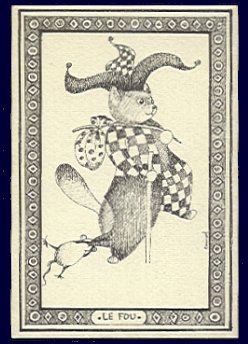 Consider the Fool, shirted in the black & white checkerboard
pattern symbolic of duality. He floats weightlessly in mid-air, looking as if he
will soon be departing the bordered confines of the card altogether. If he
manages to accomplish this, he will not be alone, for his familiar, a plump
little mouse (who takes the place of the traditional dog), hangs precariously,
frantically clutching a droopy pant leg.
Consider the Fool, shirted in the black & white checkerboard
pattern symbolic of duality. He floats weightlessly in mid-air, looking as if he
will soon be departing the bordered confines of the card altogether. If he
manages to accomplish this, he will not be alone, for his familiar, a plump
little mouse (who takes the place of the traditional dog), hangs precariously,
frantically clutching a droopy pant leg.
The Magician looks up rather impatiently from his table (which bears the tools of his trade), seemingly annoyed at being interrupted from his activities. The traditional magician’s hat, which later became a leminscate in the occult decks, functions as both in this card, strategically positioned to allow for those alert, feline ears.
La Papesse is a lovely white cat, crowned and sporting a queenly Elizabethan ruched collar. Elegantly ensconced in her throne-like chair, she looks up from her book of secret knowledge. Will she tell you anything? Ah, remember the breed here. Maybe she will, maybe she won’t.
Next, enjoy Nicod’s interpretation of Le Pape. He sits, flanked by
Vatican-like spires, triple-crowned and holding the triple-barred scepter
symbolic of his office. His jowly, worldly visage and soft, paunchy physique
speak of an over-indulgence in the finer things of this world and belie his
purported sole dedication to the spiritual..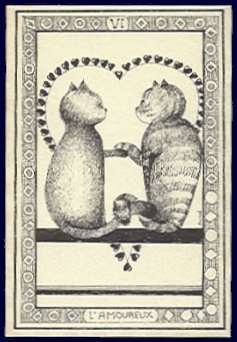
Any romantic will appreciate L’Amoureux, with its small hearts coming together to form one large heart. In the foreground sit our lovers with paws and tails entwined as they gaze soulfully at each other. It is a simple and charming image.
The whimsy continues. Two mice (pulling in opposite directions) struggle to comply with the wishes of the occupant of Le Chariot. In La Force, Strength is portrayed by a feline weightlifter who is protecting himself against any potential back injuries by wearing a weight belt.
Whimsical, yes, but there are also cards with a good deal of visual impact. Death is a striking card. No human skeleton, but that of a cat; a cloaked figure (with its long, bony tail dangling disconcertingly) clutching its scythe. Another striking and very beautiful card is L’Etoile. The more traditional pool of water (anathema to cats) has been replaced by a beautiful fountain. Water flows freely from the beaks of the two duck statues. And at the center and top of it all reigns a tall, solitary black cat, her tail fully and elegantly raised (the tip of which can be seen just over her regal head). Her eyes, starkly white with no hint of pupils, represent the turning inward necessary to the meditative state. Seven small stars flank the glorious double star of black and white which sparkles just behind the feline figure like some faceted night jewel.
La Lune continues
to reflect the evocative mood set in motion by L’Etoile. Here, we see a small
black cat, 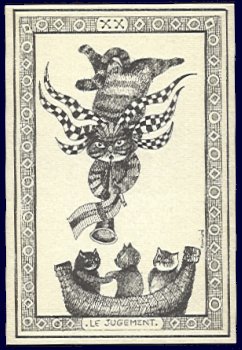 resting quietly in a high treetop from which delicate drops of night
dew fall, turned away from us as she focuses all of her attention upon the huge
quarter moon.
resting quietly in a high treetop from which delicate drops of night
dew fall, turned away from us as she focuses all of her attention upon the huge
quarter moon.
Whimsy returns in Le Jugement, where the feline trumpeter sounds the call to the three cats riding in, of all things, a small Noah’s ark.
And finally, Le Monde, which portrays a tenacious cat clinging to the large round ball of the earth, surrounded by the four traditional symbols, with one small but essential change. Here we see bird, bull, lion and…cat. No humans allowed. After all, what’s so important about our species anyway? Especially when compared to the divine cat?
There is a small introduction to the I Gatti Originali, written by Pina Andronico Tosonotti, briefly describing the fascination and reverence with which the cat has been favored for countless centuries. In the closing paragraph, the cat is described as a "little divinity," whose mystery, as portrayed by the skilled pen of Nicod, is combined with the 22 major arcana to create a dream world of fairytale. A dream world so important to childhood.
And, I would say, important to those of us adults who still secretly carry that dream world deep within ourselves.
I Gatti Originali in 22 Arcani Maggiori Di Evelyne Nicod
Edition of
1500 (Signed and Numbered)
Published by Il Meneghello
Milano, Italy
(1985)
Paula Gibby first began to study the tarot in the summer of 1996, as a result of studying Kabbalah and the Tree of Life. She completed two B.O.T.A. tarot courses and is an active member of Tarot-l and Comparative Tarot. She has contributed tarot reviews to Wicce's Tarot Page and is a major tarot collector--at present, she owns over 300 decks. Her spiritual studies continue to widen; she has completed several Reiki courses and has received the Reiki II attunements. Inspired by the work of Arnell Ando and Michele Jackson, she plans to create a tarot deck sometime in the future, but is presently quite busy as a Finance Manager in the Washington, D.C. area.
Review © 2001 Paula
Gibby
Page © 2001 Diane
Wilkes